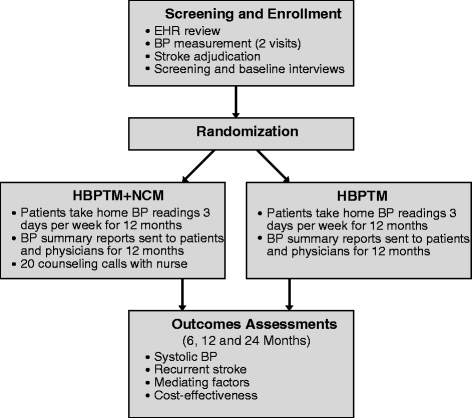Comparative effectiveness of home blood pressure telemonitoring (HBPTM) plus nurse case management versus HBPTM alone among Black and Hispanic stroke survivors: study protocol for a randomized controlled trial
- PMID: 25873044
- PMCID: PMC4365522
- DOI: 10.1186/s13063-015-0605-5
Comparative effectiveness of home blood pressure telemonitoring (HBPTM) plus nurse case management versus HBPTM alone among Black and Hispanic stroke survivors: study protocol for a randomized controlled trial
Abstract
Background: Black and Hispanic stroke survivors experience higher rates of recurrent stroke than whites. This disparity is partly explained by disproportionately higher rates of uncontrolled hypertension in these populations. Home blood pressure telemonitoring (HBPTM) and nurse case management (NCM) have proven efficacy in addressing the multilevel barriers to blood pressure (BP) control and reducing BP. However, the effectiveness of these interventions has not been evaluated in stroke patients. This study is designed to evaluate the comparative effectiveness, cost-effectiveness and sustainability of these two telehealth interventions in reducing BP and recurrent stroke among high-risk Black and Hispanic stroke survivors with uncontrolled hypertension.
Methods/design: A total of 450 Black and Hispanic patients with recent nondisabling stroke and uncontrolled hypertension are randomly assigned to one of two 12-month interventions: 1) HBPTM with wireless feedback to primary care providers or 2) HBPTM plus individualized, culturally-tailored, telephone-based NCM. Patients are recruited from stroke centers and primary care practices within the Health and Hospital Corporations (HHC) Network in New York City. Study visits occur at baseline, 6, 12 and 24 months. The primary outcomes are within-patient change in systolic BP at 12 months, and the rate of stroke recurrence at 24 months. The secondary outcome is the comparative cost-effectiveness of the interventions at 12 and 24 months; and exploratory outcomes include changes in stroke risk factors, health behaviors and treatment intensification. Recruitment for the stroke telemonitoring hypertension trial is currently ongoing.
Discussion: The combination of two established and effective interventions along with the utilization of health information technology supports the sustainability of the HBPTM + NCM intervention and feasibility of its widespread implementation. Results of this trial will provide strong empirical evidence to inform clinical guidelines for management of stroke in minority stroke survivors with uncontrolled hypertension. If effective among Black and Hispanic stroke survivors, these interventions have the potential to substantially mitigate racial and ethnic disparities in stroke recurrence.
Trial registration: ClinicalTrials.gov NCT02011685 . Registered 10 December 2013.
Similar articles
-
Home Blood Pressure Telemonitoring and Nurse Case Management in Black and Hispanic Patients With Stroke: A Randomized Clinical Trial.JAMA. 2024 Jul 2;332(1):41-50. doi: 10.1001/jama.2024.6609. JAMA. 2024. PMID: 38842799 Free PMC article. Clinical Trial.
-
Design and rationale for Home Blood Pressure Telemonitoring and Case Management to Control Hypertension (HyperLink): a cluster randomized trial.Contemp Clin Trials. 2012 Jul;33(4):794-803. doi: 10.1016/j.cct.2012.03.014. Epub 2012 Apr 1. Contemp Clin Trials. 2012. PMID: 22498720 Free PMC article. Clinical Trial.
-
Reducing Hypertension in a Poststroke Black and Hispanic Home Care Population: Results of a Pragmatic Randomized Controlled Trial.Am J Hypertens. 2020 Apr 1;33(4):362-370. doi: 10.1093/ajh/hpz148. Am J Hypertens. 2020. PMID: 31541606 Free PMC article. Clinical Trial.
-
Home Blood Pressure Telemonitoring: Rationale for Use, Required Elements, and Barriers to Implementation in Canada.Can J Cardiol. 2017 May;33(5):619-625. doi: 10.1016/j.cjca.2016.12.018. Epub 2017 Jan 3. Can J Cardiol. 2017. PMID: 28279522 Review.
-
Telemedical strategies for improving systolic blood pressure control in secondary prevention of cerebrovascular events-a systematic review and meta-analysis.J Stroke Cerebrovasc Dis. 2024 Dec;33(12):108046. doi: 10.1016/j.jstrokecerebrovasdis.2024.108046. Epub 2024 Sep 30. J Stroke Cerebrovasc Dis. 2024. PMID: 39357612
Cited by
-
TASC (Telehealth After Stroke Care): a study protocol for a randomized controlled feasibility trial of telehealth-enabled multidisciplinary stroke care in an underserved urban setting.Pilot Feasibility Stud. 2022 Apr 11;8(1):81. doi: 10.1186/s40814-022-01025-z. Pilot Feasibility Stud. 2022. PMID: 35410312 Free PMC article.
-
Home Blood Pressure Monitoring.Eur Cardiol. 2015 Dec;10(2):95-101. doi: 10.15420/ecr.2015.10.2.95. Eur Cardiol. 2015. PMID: 30310433 Free PMC article. Review.
-
The Time Is Now for eHealth Research With Latinos.Am J Public Health. 2017 Nov;107(11):1705-1707. doi: 10.2105/AJPH.2017.304055. Am J Public Health. 2017. PMID: 29019786 Free PMC article. No abstract available.
-
Interventions for improving modifiable risk factor control in the secondary prevention of stroke.Cochrane Database Syst Rev. 2018 May 7;5(5):CD009103. doi: 10.1002/14651858.CD009103.pub3. Cochrane Database Syst Rev. 2018. PMID: 29734470 Free PMC article.
-
Telehealth After Stroke Care Pilot Randomized Trial of Home Blood Pressure Telemonitoring in an Underserved Setting.Stroke. 2022 Dec;53(12):3538-3547. doi: 10.1161/STROKEAHA.122.041020. Epub 2022 Oct 31. Stroke. 2022. PMID: 36314123 Free PMC article. Clinical Trial.
References
-
- Lackland DT, Roccella EJ, Deutsch AF, Fornage M, George MG, Howard G, et al. Factors influencing the decline in stroke mortality: a statement from the American Heart Association/American Stroke Association. Stroke. 2014;45:315–53. doi: 10.1161/01.str.0000437068.30550.cf. - DOI - PMC - PubMed
Publication types
MeSH terms
Substances
Associated data
Grants and funding
LinkOut - more resources
Full Text Sources
Other Literature Sources
Medical


